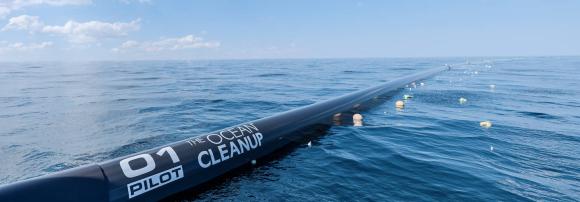 Much of the media have taken the claims of Boyan Slat at face value. The young Dutch engineer has claimed that his design for a series of floating ocean booms will clean the oceans of plastic. The BBC headline in 2014 which read, “The Dutch boy mopping up a sea of plastic” was pretty typical, reflecting the assumption that Slat’s design would work as intended. The media and Slat’s supporters really want to believe that the young engineer had found the solution for cleaning plastics from the oceans.
Much of the media have taken the claims of Boyan Slat at face value. The young Dutch engineer has claimed that his design for a series of floating ocean booms will clean the oceans of plastic. The BBC headline in 2014 which read, “The Dutch boy mopping up a sea of plastic” was pretty typical, reflecting the assumption that Slat’s design would work as intended. The media and Slat’s supporters really want to believe that the young engineer had found the solution for cleaning plastics from the oceans.
Impressively, Slat and his non-profit Ocean Cleanup succeeded in raising $20 million to fabricate and deploy a 600-meter-long prototype boom designed to trap and collect plastic refuse. It was towed 1,400 miles offshore to the so-called Great Pacific Garbage Patch for trials. Unfortunately, the prototype boom did not collect significant amounts of plastic as it was designed to do, and, worse, broke apart due to wave action. It will be towed back to California as weather permits.
As with all new technology, Ocean Cleanup’s new plastic catching boom may simply need more development and testing. Nevertheless, even if it is successful, the claims made by Ocean Cleanup seem unduly optimistic. The claim that “our models indicate that a full-scale system roll-out could clean up 50% of the Great Pacific Garbage Patch in 5 years.”
Even if these problems can be fixed, there is a problem with the numbers. If the boom plastic collectors can be made to work, the scale would be massive, requiring an estimated 24 floating booms about 1,000 kilometers long (621 miles) at strategic spots in the ocean. The claim that the system could clean up half the Pacific Garbage Path in 5 years is impressive but insufficient. The Patch is estimated to have at least 80 million tons of plastic. To clean up half in five years would require removing 8 million tonnes per year, which is great, except that currently, another 8 million tonnes of plastic is dumped in the ocean every year.
Whether the shortcoming of the current boom design can be remedied remains to be seen. The New York Times quotes Nicholas Mallos, director of the Trash Free Seas program at the Ocean Conservancy, saying, “It is very difficult to predict what will take place in these very dynamic ocean environments.”
Many critics think that massive ocean booms are the wrong approach entirely. Chris Clarke writing in KCET.org posted “6 Reasons That Floating Ocean Plastic Cleanup Gizmo is a Horrible Idea,” back in 2015. His first two points were that “ocean plastic doesn’t behave the way the project’s backers say it does,” so the booms are unlikely to perform as intended. His second point is that the “collectors will break really, really quickly.”
Both points were proven to be exactly right. At least so far, the boom collector has not collected much plastic and, the boom broke after a few months in service.
Mr. Mallos praised the Ocean Cleanup for helping turn world attention to a major environmental problem. But he said stopping plastics before they enter the ocean from beaches and local waterways was a more effective approach, along with reducing overall plastic use.
Clarke also argues that it’s far more efficient, cheaper, and safer to keep the plastic out of the ocean in the first place. The obvious problem is that, unlike appealing technology, reducing plastic waste, while being far more efficient, offers no “magic bullet” to solve our problems.
It is a problem that bridges the developed and the developing worlds and will require both cooperation and investment. China, Indonesia, the Philippines, Thailand, and Vietnam are dumping more plastic into the oceans than the rest of the world combined, according to a 2017 report by the Ocean Conservancy. The problem is not limited to Asia, however. The United States ranks in the top 20 countries ranked by mass of mismanaged plastic waste (at number 20) and dumps up to 110,000 tonnes of plastic yearly into the oceans.
While technological fixes to clean up our oceans are appealing, the real answer is to use less disposable plastic, to do a better job recycling what we use, and to work with nations around the world to keep plastic out of the ocean.
As Chris Clarke noted three years ago, “Once that plastic gets to the ocean, there’s no technological quick fix, no matter how much we might want there to be one. We’ve got to stop counting on some bright young inventor to save the planet and start doing it ourselves.”

Its too bad there is no easy fix. Yes it would have been splendid if this had succeeded.
Granted the alternative would be to go back to the biodegradable solution of using paper products.
” It was towed 1,400″, what?
1,400 Miles?